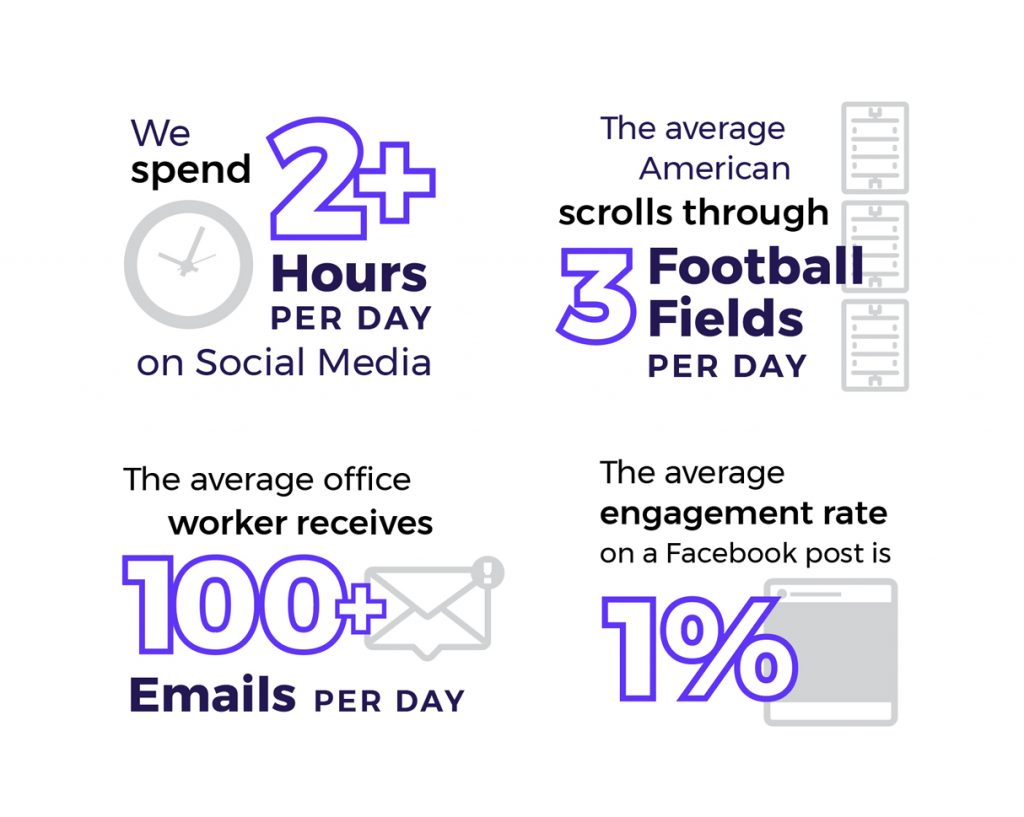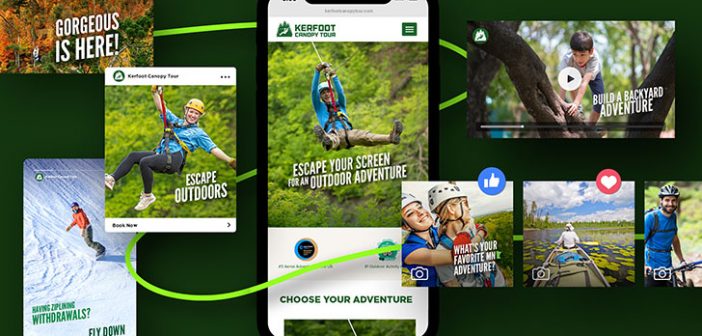Grab your phone and open up Instagram, Facebook, or TikTok. Look through the last few things you and some of your closest friends posted.
If your social media feeds look anything like mine right now, you’re probably seeing smiles accompanied by gorgeous backdrops from recent adventures with loved ones, shots of homemade crusty sourdough bread or other newly discovered quarantine hobbies, and perhaps a shared post about something you or a friend found funny, inspiring, or just worth sharing. And then there’s the political gobbledygook, but we’ll scroll past that.
Each of these posts tell a story—your story. This is why we open Facebook and Instagram, to share our stories, and learn from and be entertained by the stories of others.
Now take a quick look through the five most recent posts from your adventure company’s Facebook or Instagram. If it’s like many (most!) of the adventure parks I’ve seen, the approach probably falls into one of three camps:
• The Needy Camp: Companies that only post on Facebook when they need something—we’re hiring guides, we have an upcoming sale and want to drive purchases, we have extra spots on the 5 p.m. tour, etc.
• The Announcement Camp: Companies that treat social media like their website’s announcement banner—we’re closed for repairs this Sunday; here are some updates to our COVID policies; the season ends next Saturday, etc.
• The “I don’t know what to post” Camp: Then, there’s the company that will share anything and everything—we spotted a deer on our property!; here’s a funny cat meme; we’re so excited that Hamilton is now streaming on Disney Plus! etc. And sometimes, this company will go months without sharing anything at all.
There’s good and bad in each of these camps. But the core issue is the same for each: they’re not telling a consistent and engaging brand story.
Let’s look at how to tell your brand’s story in a way that’s engaging and aligned with the reasons your brand exists in the first place. But first, let’s ponder a few reasons why brand storytelling needs to be a core part of your digital marketing strategy.
Why Brand Storytelling Is Crucial Right Now
There’s a massive opportunity to reach people (for free or low cost) with relevant, compelling content. Americans now spend more time on the internet than ever before. We spend an average of 2+ hours a day on social media alone. If you printed out what the typical American scrolls through on social media in a given day, it would cover nearly three football fields. And if that’s not enough, the average American office worker receives more than 100 emails per day.
So, for better or worse, your audience is spending a lot of time on social media. With that comes a lot of competition. Consider:
• The average open rate for emails from “travel and hospitality” brands is right around 16 percent.
• The average click rate for opened emails from “travel and hospitality” brands is less than 2 percent.

The best way to stand out in a crowded, sprawling social media world is through brand storytelling.
• When you post something on Facebook, you’re lucky if 5 percent of the people who see the post engage with it in some way. Average engagement rates are less than 1 percent.
The reality is, every time you post something to social media or send out an email newsletter, you’re just a speck in the newsfeed or inbox. To make your investment on these digital channels worth it, your speck needs to stand out in the crowd. The best way I’ve found to do this is through brand storytelling.
What is Brand Storytelling?
“Brand storytelling is your company’s honest narrative that builds connections with your audience around shared interests and experiences,” says Blend Marketing creative director Matt Kempel. “Your brand story is your unique way to create affinity, trust, and long-term relationships with your fans.”
One of the hardest parts about being in the aerial adventure business is that a lot of people may consider your offering as a “once in a lifetime” experience. Communicating an effective brand story will keep customers talking before and long after their “once in a lifetime” experience, and will probably turn them into repeat visitors.
What Story Should Your Brand Tell?
Social media posts, email newsletters, and websites that stand out in the crowd and resonate most with fans (and potential fans) focus on sharing content that lives at the intersection of three things:
1. Who you are as a company (your mission, vision, and values).
2. The identity of your audience, including their (current) needs and wants.
3. What you can offer your audience to meet those needs and wants.
These are key elements of how you position your brand in the market. Any misalignment or imbalance here can quickly cause your story to fall flat, and even damage your brand.
How you position yourself in the market can have a massive impact on the return on your investment in social media, advertising, your website, and more.
Brand positioning is fundamental to any adventure business. Think of brand positioning as how you want to be thought of as a company. And it’s crucial that everyone on your team knows what that looks like.
If there’s any ambiguity in the mind of you or your team about your mission, your audience, and what you can offer your audience, you should pause and work through your brand positioning. With some research, it’s possible to go through a brand positioning process in-house, but it’s usually worth involving a branding expert. Here are three books I highly recommend that will start you down the right path:
1. Positioning: The Battle For Your Mind
2. Get to Aha! Discover Your Positioning DNA and Dominate Your Competition
3. Building a StoryBrand: Clarify Your Message so Customers Will Listen
Continuing Grandma’s Legacy
To illustrate the importance of full company alignment on the mission, the audience, and the offer, let’s look at Kerfoot Canopy Tour—a zip line tour and adventure park just outside of the Twin Cities in Minnesota.
Kerfoot Canopy Tour is owned by Lee Kerfoot, whose grandmother was a legendary Minnesota Northwoods pioneer. The stated company goal is “to continue Grandma’s legacy of connecting others to nature through outdoor adventure.”
The operation includes a zip line tour, high ropes challenge course, and a 400-foot “ball run”—a wooden track that winds through the forest and carries each participant’s wooden ball through an epic series of obstacles.
How should a company like Kerfoot Canopy Tour build its fan base as it heads into its shoulder season in the middle of a pandemic? Start by answering our three questions:
1. Who is it as a company—why does the company exist?
Kerfoot Canopy Tour is about connecting people to nature through outdoor
adventure. Importantly, it is not primarily about zip lining, thrill-seeking, or pushing limits.
2. What is the identity of the audience, including their current needs and desires?
Its audience is people who enjoy being outdoors in Minnesota, and/or who want to get themselves or their kids away from couches and screens, at least for a time. In the midst of COVID-19, those needs are heightened as people look for ways to enjoy the outdoors in household units (smaller groups) and without crowds.
3. What does Kerfoot Canopy Tour offer to meet the audience’s needs and desires?
Its three activities are about having fun in and near the woods, specifically in Minnesota, near the Twin Cities. The team has done a good job of positioning their offerings as unforgettable experiences that enable guests to “escape outdoors”—which is well aligned with their mission.
Focus on What Makes You Different
With those answers in mind, Kerfoot Canopy Tour can confidently share its brand story in a way that uniquely builds connections and meets the needs of its audience through offers and products that further the brand’s mission.
For example, Kerfoot might:
• Solicit ideas from its fan base about how to enjoy the Minnesota outdoors (other than just going zip lining), and then share those ideas in a monthly newsletter.
• Share a short video about how to build your own backyard adventure as a way to connect with the outdoors in a new way.
• On the park’s website, refer to the experiences as the “cure” for indoor boredom or as an escape to the outdoors, rather than flexing how fast, high, and long the zip lines are.
• Promote other activities during the winter when there’s less demand for zip lining.
Adventures for All Ages
Another example of a company that understands its mission and audience is Highlands Aerial Park (HAP) in Highlands, N.C. Answering our three questions helps jump start brainstorming what kind of brand stories it needs to tell.
1. Who are we, and why do we exist?
HAP’s primary mission is to enable multi-generational families to create memories and experience adventure.
2. Who is our audience? (Including their current needs and desires)
HAP’s audience is typically families—often multi-generational families—looking to create memories through an outdoor experience. Many of these families vacation regularly to the area or live within driving distance and are seeking out family day trips.
3. What do we offer to meet the audience’s needs and desires?
The combination of HAP’s three activities—a giant swing, a kids’ ropes course, and a zip line course—are approachable enough where most families can find something for everyone to enjoy. HAP is also looking to roll out scenic UTV tours as a way to better serve grandparents in particular.
With its mission and audience in mind, HAP might:
• Share photos and stories from grandparents and parents connecting with their kids and grandkids in new ways at HAP.
• Position its activities as something that people of all ages can enjoy.
• Share a message or video on why HAP feels creating multi-generational experiences and memories are so important.
• Post-pandemic, offer discounts for large family reunion events that bring multiple generations of the family together. Such discounts reinforce “affordable family adventures” as a shared interest that helps build connections with HAP’s audience.
Regardless of the kind of adventure company you are, you can tell a powerful brand story if you know who you are as a company, know the needs of your audience, and have a product or offer that can meet your audience’s needs in a unique way.
Shaping the Future of Your Brand
Keep these three ideas in mind as you tell your company’s story.
1. Be honest in your storytelling. Misleading your fan base can lead to unhappy customers. If your adventure is intense and challenging, it should look intense and challenging. If it’s great for families, you should share videos and images of families.
2. Be timely with your storytelling. If it’s November, and you’re located in New England, don’t post a photo of someone in shorts and a t-shirt zip lining. If there’s rain in the forecast for the next seven days, post a cool shot of someone zip lining through the rainy mist, and talk about how your tour sizes are typically smaller when it rains (if they actually are).
3. Stories are powerful. They give employees and stakeholders something to rally around. They give customers something to share and talk about long after they participate in your adventure. And they give potential customers something to dream about.
So, build your fan base for the long term, and start telling your brand’s unique story.
Blend Marketing has compiled some of its favorite examples of good brand stories from adventure operators who are crushing it right now. You can find it all here: blend.travel/storytelling






